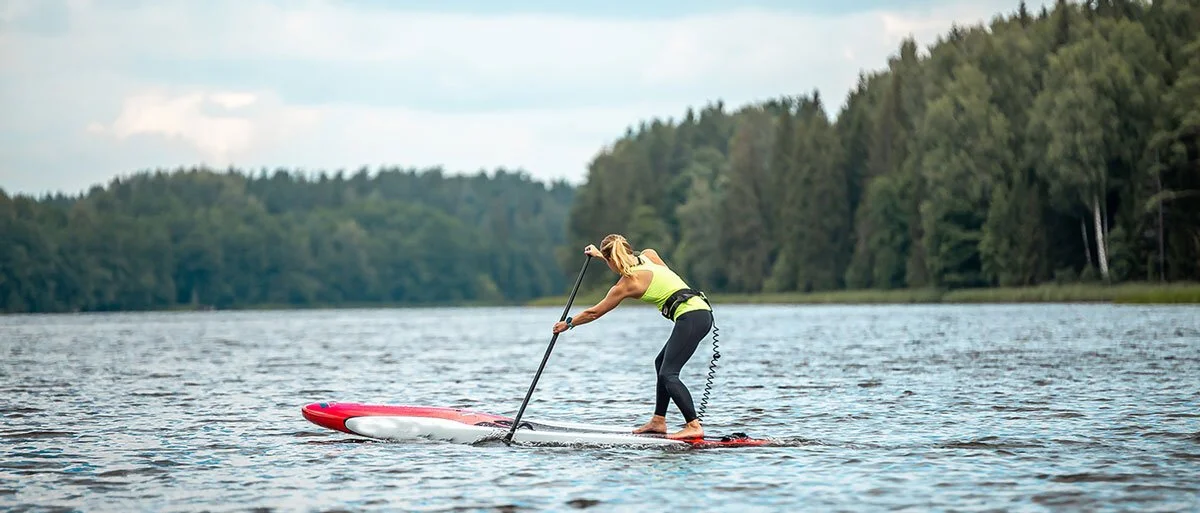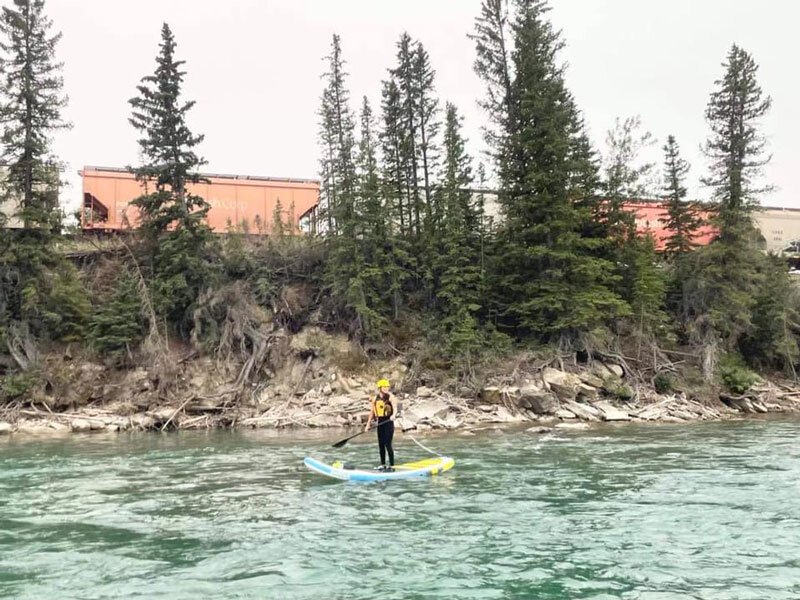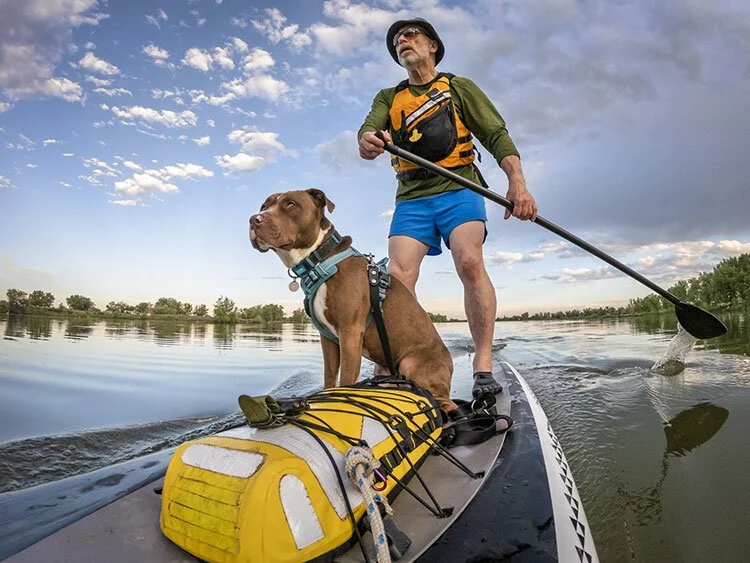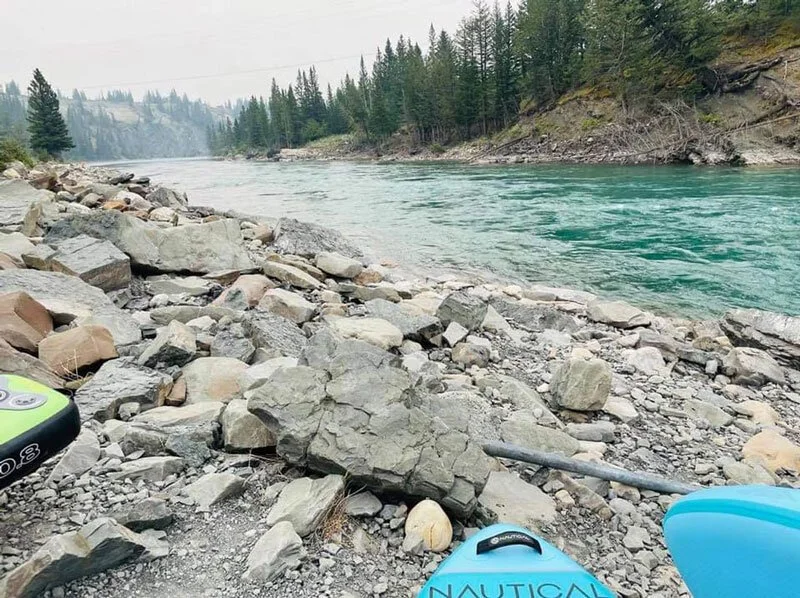DRY LAND TRAINING FOR SUP ADVENTURES
By Senior Coach Jill
Approximate Reading Time: 4-6min
STARTING POINTS
I love stand up paddleboarding (SUP)! SUP started gaining traction around 2005 and is one of the fastest growing sports ranging from the leisurely sit down paddler to the white water racer. I bought my first board in 2015 and thought my skills were pretty decent until I took a flat water basics class in July to refresh my skills before moving on to introductory river SUP and advanced paddling lessons. My biggest take away was that my front stroke needed (and still needs) some tweaking. Whatever your jam, if you’re ready to up your SUP game, the front stroke is your best friend when performed well and requires a few things we just love to coach at Restore Human.
STEP 1. A SOLID HINGE
Did you know the main force of the SUP front stroke actually comes from your posterior chain (or backside) not your arms? The action of standing up from the hinged position after putting paddle to water with straight arms is what drives you forward more efficiently. Developing a strong and technically sound hinge on dry land can help you cover more distance on the water, help you power through tough conditions when wind or currents pick up and mitigate lower back strain from improper pelvic and spinal alignment.
Addressing single leg or unilateral hinge work along with bilateral hinge will also help with balance when you have to change your stance position on the board.
STEP 2. STRAIGHT ARM SCAPULAR STRENGTH
Maintaining the straight arm position holding the paddle can be challenging while balancing, keeping your hinge in good working order and dealing with the force of the water against the paddle but it is super important. When you primarily use your arm muscles when bending at the elbow, you're actually trying to pull your way through the water. This is a major energy leak - you’re going nowhere fast. In the straight arm position, most of the action is coming from the big latissimus dorsi muscles (the upper body equivalent to the glutes in the lower body). Maintaining shoulder joint health is crucial to mitigate overuse injuries. Shoulder circles are a fantastic addition to your daily movement practice. The Restore Human method has several strategies for straight arm scapular strength. There is one particular exercise that can be used in conjunction with conditioning the next element for a solid front stroke - rotational core strength.
STEP 3. ROTATIONAL CORE STRENGTH
Rotational core strength and an efficient front stroke go hand in hand. Ideally, when the paddle cuts the water it should be perpendicular with your hands stacked on top of each other which requires your torso to rotate. Add in your powerful hinge to draw the blade through the water with your amazing straight arms and you’ve got a lot of force drawing though your core - front and back! Riffs on the palloff press, can help prepare you to manage rotational push and pull forces and help to avoid lower back pain which keeps you on the board for longer stretches. Incorporating sandbag getups in your strength training will also benefit your strength in rotation.
STEP 4. ANKLE AND HIP MOBILITY
While not having optimal mobility in your hips and ankles isn’t a deal breaker when it comes to the front stroke it’s worthwhile touching upon. At some point you’re going to fall in and have to get back up on your board.
One of the biggest deterrents for people to actually stand up on the board, in my opinion, is lack of mobility not balance. The ability to transition from a squat or split squat to standing is most effective and efficient while maintaining stability and balance - I’m talking to you, ankles. You don’t have to have a “perfect” deep squat to get up on your board; but, increasing your range of motion in dorsiflexion will definitely help.
OK, now you’re in the water and need to get back on. Can you swing your knee up enough? In my experience (because I’ve asked/forced several people to go SUPing with me) lack of hip mobility makes it extremely difficult to climb back on the board. Daily hip circles and standing hip flexion isometrics are a great start to SUP hip health and can help with your balance as well!
STEP 5. BALANCE
Bow River views!
Of course you need to work on your balance! When I’m encouraging/badgering people to join me for a SUP their prime concern is with balance. If your joints are in healthy ranges of mobility, the balance will come. Learning key Restore human concepts like task appropriate tension, joint position sense and kinaesthesia (aka, muscle sense) are beneficial to better balance.
TO SUP UP
While I’ve tackled the elements of the front stroke separately, they all work in unison. Dryland training to strengthen each element individually is a great strategy to improve your strength, grace and resilience on the water. One BIG caveat - this article is not intended to give advice on or teach proper SUP paddling techniques. My aim is to provide some tools to enhance your physicality while pursuing SUP adventures. I highly recommend taking courses by a qualified and certified body. I learned amazing things from canrvrsup.ca here in Alberta. Paddle Canada at www.paddlecanada.com is a great place to start looking for qualified instructors. Hope you enjoy your adventures on the water!
By Senior Coach Jill
Senior Coach Jill is based in Calgary and takes virtual and in-person clients, more details at www.restorehumancalgary.com.






